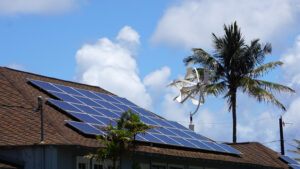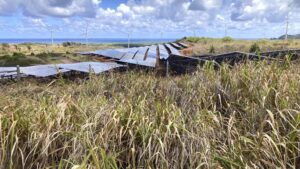Hawaii’s Ordeal Worsens: Lava Torrents, Flying Rocks, Acidic Air
Exploding magma from the Big Island's Kilauea volcano cuts off a highway and reaches the ocean. Flying lava hits a man, shattering his leg. Magma erupting from five fissures merges to form a river of lava that flowed to the Pacific Ocean on Hawaii's Big Island on Saturday. (U.S. Geological Survey)
Magma erupting from five fissures merges to form a river of lava that flowed to the Pacific Ocean on Hawaii's Big Island on Saturday. (U.S. Geological Survey)
PAHOA, Hawaii—A volcano that is oozing, spewing and exploding on Hawaii’s Big Island has gotten more hazardous in recent days, with rivers of molten rock flowing into the ocean and flying lava causing the first major injury.
Kilauea volcano began erupting more than two weeks ago and has burned dozens of homes, forced people to flee and shot up plumes of steam from its summit that led officials to distribute face masks to protect against ash particles.
Lava flows have grown more vigorous in past days, spattering molten rock that hit a man in the leg.
He was outside his home Saturday in the remote, rural region affected by the volcano when the lava “hit him on the shin, and shattered everything from there down on his leg,” Janet Snyder, Hawaii County mayor’s spokeswoman, told the Hawaii News Now TV station.
Lava that’s flying through the air from cracks in the Earth can weigh as much as a refrigerator and even small pieces can be lethal, officials said.
The injury came the same day lava streamed across a highway and flowed into the ocean. The phenomenon sends hydrochloric acid and steam with fine glass particles into the air and can lead to lung damage and eye and skin irritation, another danger for residents as the plume can shift with the wind, the Hawaii County Civil Defense agency said.
The highway has shut down in some spots, and residents in the area have been evacuated.
With the problems compounding, scientists can’t say whether lava flows from nearly two dozen fissures will keep advancing or stop.
“We have no way of knowing whether this is really the beginning or toward the end of this eruption,” said Tom Shea, a volcanologist at the University of Hawaii. “We’re kind of all right now in this world of uncertainty.”
The area affected by lava and ash is small compared with the Big Island, which is about 4,000 square miles (10,360 square kilometers). The volcano has spared most of the island and the rest of the Hawaiian chain.
Officials have reminded tourists that flights, including on the Big Island, have not been affected. Even on the Big Island, most tourist activities are available and businesses are open.
Evacuation orders for two neighborhoods with nearly 2,000 people were given after the first fissure opened on May 3. Officials have been warning neighboring communities to be prepared to evacuate.
Lava flows have sped up as fresher magma mixes with decades-old magma, creating hotter and more fluid flows, scientists said. Two fissures had merged by Saturday, creating a wide flow moving at up to 300 yards (274 meters) per hour.
Edwin Montoya, who lives with his daughter on her farm near where lava crossed a roadway and trapped a handful of people Friday, said the fissure opened and grew quickly.
“It was just a little crack in the ground, with a little lava coming out,” he said. “Now it’s a big crater that opened up where the small little crack in the ground was.”
___
Kelleher reported from Honolulu. Associated Press journalists Jae Hong and Marco Garcia in Pahoa contributed to this report.
Your support matters…Independent journalism is under threat and overshadowed by heavily funded mainstream media.
You can help level the playing field. Become a member.
Your tax-deductible contribution keeps us digging beneath the headlines to give you thought-provoking, investigative reporting and analysis that unearths what's really happening- without compromise.
Give today to support our courageous, independent journalists.






You need to be a supporter to comment.
There are currently no responses to this article.
Be the first to respond.